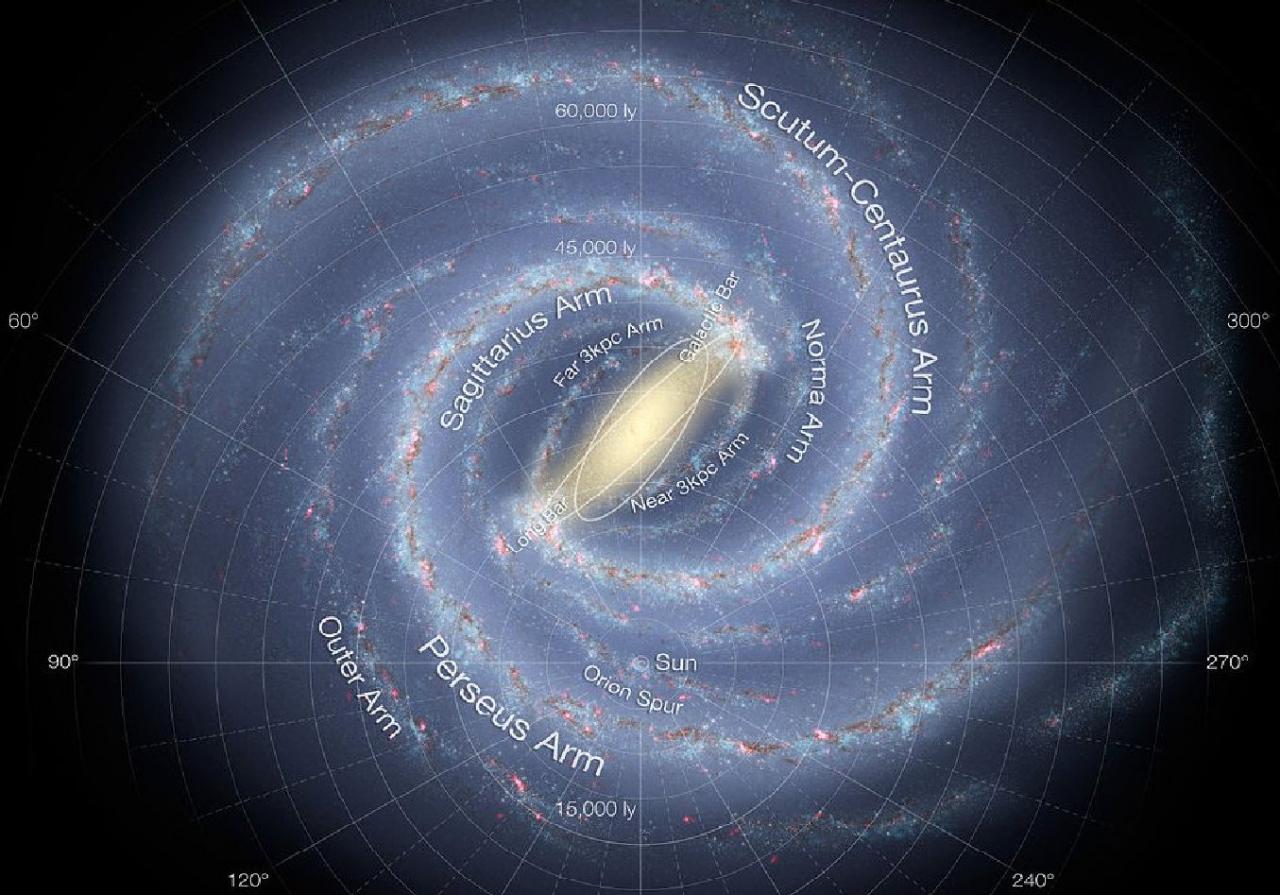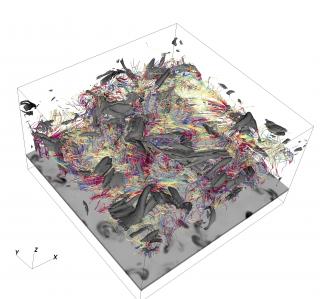Grants related:
General
This project consists of two parts, each differentiated but both complementary: morphology and dynamics. Detailed study of the morphology of the Milky Way pretends to provide a data base for the stellar distribution in the most remote and heavily obscured regions of our Galaxy, through the development of semiempirical models based on the information in these catalogues. Kinematic and dynamical analysis, on the other hand, aims to aid our understanding of the origin of these observed features.
Our group has used a combination of its own data (which will include in the future spectroscopical observations with GRANTECAN/EMIR) and public-domain catalogues either in photometry (DENIS, 2MASS, UKIDSS, VISTA, SDSS) or spectroscopy (SDSS-APOGEE in near infrared, LAMOST). We have gathered detailed information on the stellar distribution of the dominant populations over a wide area of sky containing different structural components: the triaxial bulge, the long bar, the disc, the spiral arms, etc. The components of gas and dust are also a matter of study in infrared, or in microwave (analyses of Galactic contamination over the cosmic microwave background radiation, for instance with WMAP or PLANCK). Our research team has also become part of the Spanish node of Gaia with the idea of orientating part of our work towards the scientific exploitation of this mission, particularly with regard to the identification and study of large scale stellar populations in the Galaxy.
Members
Results
- Milky Way's disk much larger than previously thought. See press release of IAC: http://www.iac.es/divulgacion.php?op1=16&id=1385&lang=en
Scientific activity
Related publications
-
The Herschel Multi-tiered Extragalactic Survey: SPIRE-mm photometric redshifts
We investigate the potential of submm-mm and submm-mm-radio photometric redshifts using a sample of mm-selected sources as seen at 250, 350 and 500μm by the SPIRE instrument on Herschel. From a sample of 63 previously identified mm sources with reliable radio identifications in the Great Observatories Origins Deep Survey North and Lockman Hole
Roseboom, I. G. et al.Advertised on:
22012 -
Submillimetre galaxies reside in dark matter haloes with masses greater than 3×1011 solar masses
The extragalactic background light at far-infrared wavelengths comes from optically faint, dusty, star-forming galaxies in the Universe with star formation rates of a few hundred solar masses per year. These faint, submillimetre galaxies are challenging to study individually because of the relatively poor spatial resolution of far-infrared
Amblard, Alexandre et al.Advertised on:
22011 -
HerMES: SPIRE emission from radio-selected active galactic nuclei
We examine the rest-frame far-infrared emission from powerful radio sources with 1.4-GHz luminosity densities of 25 ≤ log(L1.4/W Hz-1) ≤ 26.5 in the extragalactic Spitzer First Look Survey field. We combine Herschel/SPIRE flux densities with Spitzer/Infrared Array Camera and Multiband Imaging Photometer for Spitzer infrared data to obtain total (?m
Seymour, N. et al.Advertised on:
52011 -
VVV DR1: The first data release of the Milky Way bulge and southern plane from the near-infrared ESO public survey VISTA variables in the Vía Láctea
Context. The ESO public survey VISTA variables in the Vía Láctea (VVV) started in 2010. VVV targets 562 sq. deg in the Galactic bulge and an adjacent plane region and is expected to run for about five years. Aims: We describe the progress of the survey observations in the first observing season, the observing strategy, and quality of the data
Saito, R. K. et al.Advertised on:
12012 -
VISTA Variables in the Via Lactea (VVV): The public ESO near-IR variability survey of the Milky Way
We describe the public ESO near-IR variability survey (VVV) scanning the Milky Way bulge and an adjacent section of the mid-plane where star formation activity is high. The survey will take 1929 h of observations with the 4-m VISTA telescope during 5 years (2010-2014), covering ˜109 point sources across an area of 520 deg2, including 33 known
Minniti, D. et al.Advertised on:
72010 -
The Value of the Fine Structure Constant over Cosmological Times
The optical spectra of objects classified as QSOs in the Sloan Digital Sky Survey Data Release 6 are analyzed with the aim of determining the value of the fine structure constant in the past and then checked for possible changes in the constant over cosmological timescales. The analysis is done by measuring the position of the fine structure lines
Gutiérrez, C. M. et al.Advertised on:
42010 -
The age of extremely red and massive galaxies at very high redshift
Aims: We present a determination of the intrinsic colors and ages of galaxies at very high redshift, in particular old galaxies (OGs) within extremely red objects (EROs). To date, the definition of EROs has been restricted to objects with z < 2.5, however, here we consider objects with the same properties but shifted to higher redshifts (z > 2.5)
Castro-Rodríguez, N. et al.Advertised on:
12012 -
Pending Problems in QSOs
Quasars (Quasi Stellar Objects, abbreviated as QSOs) are still nowadays, close to half a century after their discovery, objects which are not completel y understood. In this brief review a description of the pending problems, inconsistencies and caveats in the QSO's research is presented. The standard paradigm model based on the existence of very
López-Corredoira, M.Advertised on:
62011 -
On the non-evolution of the dependence of black hole masses on bolometric luminosities for QSOs
There are extremely luminous quasi stellar objects (QSOs) at high redshift which are absent at low redshift. The lower luminosities at low redshifts can be understood as the external manifestation of either a lower Eddington ratio or a lower mass. To distinguish between both effects, we determine the possible dependence of masses and Eddington
López-Corredoira, M. et al.Advertised on:
32012 -
Modelling star counts in the Monoceros stream and the Galactic anti-centre
Context. There is a continuing debate as to the form of the outer disc of the Milky Way galaxy, which has important implications for understanding the Galaxy's formation. Stars are known to exist at a galacto-centric distance of at least 20 kpc. However, there is much debate as to whether these stars can be explained as part of the disc or whether
Hammersley, P. L. et al.Advertised on:
32011 -
Kinetic power of quasars and statistical excess of MOJAVE superluminal motions
Aims: The MOJAVE (MOnitoring of Jets in AGN with VLBA Experiments) survey contains 101 quasars with a total of 354 observed radio components that are different from the radio cores, among which 95% move with apparent projected superluminal velocities with respect to the core, and 45% have projected velocities larger than 10c (with a maximum
López-Corredoira, M. et al.Advertised on:
82012 -
Intrinsic Colors and Ages of Extremely Red Elliptical Galaxies at High Redshift
In order to know the formation epoch of the oldest elliptical galaxies as a function of mass and observed redshift, a statistical analysis of 333 extremely red objects (EROs) classified as old galaxies (OGs) at 0.8
López-Corredoira, MartínAdvertised on:
22010 -
Angular Size Test on the Expansion of the Universe
Assuming the standard cosmological model to be correct, the average linear size of the galaxies with the same luminosity is six times smaller at z = 3.2 than at z = 0; and their average angular size for a given luminosity is approximately proportional to z-1. Neither the hypothesis that galaxies which formed earlier have much higher densities nor
López-Corredoira, MartínAdvertised on:
12010 -
Analysis of possible anomalies in the QSO distribution of the Flesch & Hardcastle catalogue
Aims:A recent catalogue by Flesch & Hardcastle presents two major anomalies in the spatial distribution of QSO candidates: i) an apparent excess of such objects near bright galaxies, and ii) an excess of very bright QSO candidates compared to random background expectations in several regions of the sky. Because anyone of these anomalies would be
López-Corredoira, M. et al.Advertised on:
32008 -
Astrometry with Carte du Ciel plates, San Fernando zone . II. CdC-SF: a precise proper motion catalogue
Context. The historic plates of the Carte du Ciel, an international cooperative project launched in 1887, offer valuable first-epoch material for the determination of absolute proper motions. Aims: We present the CdC-SF, an astrometric catalogue of positions and proper motions derived from the Carte du Ciel plates of the San Fernando zone
Vicente, B. et al.Advertised on:
12010 -
Metallicity distribution of red giants in the Inner Galaxy from near infrared spectra
Context: The existence in the Milky Way of either a long thin bar with a half length of 4.5 kpc and a position angle of around 45° with respect to the Sun-Galactic centre line or a bulge+bar complex, thicker and shorter, with a smaller tilt respect to the Sun-GC line, has been a matter of discussion in recent decades. Aims: In this paper, we
González-Fernández, C. et al.Advertised on:
22008 -
Estimation of Galactic Model Parameters in High Latitudes with SDSS
We estimated the Galactic model parameters for a set of 36 high-latitude fields included in the currently available Data Release 5 (DR 5) of the Sloan Digital Sky Survey (SDSS), to explore their possible variation with the Galactic longitude. The thick disc scaleheight moves from ˜550 pc at 120°
Bilir, S. et al.Advertised on:
02008 -
Water-ice-driven Activity on Main-Belt Comet P/2010 A2 (LINEAR)?
The dust ejecta of Main-Belt Comet P/2010 A2 (LINEAR) have been observed with several telescopes at the Observatorio del Roque de los Muchachos on La Palma, Spain. Application of an inverse dust tail Monte Carlo method to the images of the dust ejecta from the object indicates that a sustained, likely water-ice-driven, activity over some eight
Moreno, F. et al.Advertised on:
82010 -
Transformations from WISE to 2MASS, SDSS and BVI Photometric Systems: II. Transformation Equations for Red-Clump Stars
We present colour transformations for the conversion of Wide-Field Survey Explorer W1, W2, and W3 magnitudes to the Johnson-Cousins BVIc, Sloan Digital Sky Survey gri, and Two Micron All Sky Survey JHKs photometric systems, for red clump (RC) stars. RC stars were selected from the Third Radial Velocity Experiment Data Release. The apparent
Bilir, S. et al.Advertised on:
32012 -
Transformations between the WISE, 2MASS, SDSS and BVRI photometric systems - I. Transformation equations for dwarfs
We present colour transformations for the conversion of the W1 and W2 magnitudes of the Wide-field Infrared Survey Explorer (WISE) photometric system to the Johnson-Cousins BVRI, Sloan Digital Sky Survey gri and Two-Micron All-Sky Survey JHKs photometric systems, for dwarfs. The W3 and W4 magnitudes were not considered due to their insufficient
Bilir, S. et al.Advertised on:
112011



